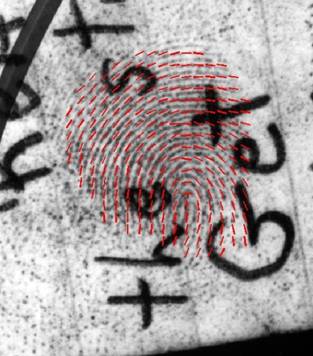
Automatic feature extraction in latent fingerprints is extremely challenging due to poor quality of most latents, such as unclear ridge structures, overlapped lines and letters, and overlapped fingerprints.
- X. Yang, J. Feng, J. Zhou, "Localized dictionaries based orientation field estimation for latent fingerprints", IEEE Transactions on Pattern Analysis and Machine Intelligence, vol. 36, no. 5, pp. 955-969, 2014. (project)
- J. Feng, J. Zhou, A.K. Jain, "Orientation field estimation for latent fingerprint enhancement", IEEE Transactions on Pattern Analysis and Machine Intelligence, vol. 35, no. 4, pp. 925-940, 2013. (project)
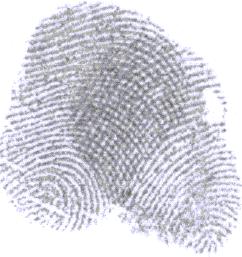
Overlapped fingerprints are not unusual in latent fingerprints taken from crime scenes. However, separating overlapped fingerprints into individual fingerprints is a very challenging problem for both existing automatic fingerprint recognition systems and human fingerprint experts. We proposed algorithms for separating overlapped fingerprints.
- J. Feng, Y. Shi, J. Zhou, "Robust and efficient algorithms for separating latent overlapped fingerprints", IEEE Transactions on Information Forensics and Security, vol. 7, no. 5, pp. 1498-1510, 2012.
- F. Chen, J. Feng, A.K. Jain, J. Zhou, J. Zhang, "Separating overlapped fingerprints", IEEE Transactions on Information Forensics and Security, vol. 6, no. 2, pp. 346-359, 2011.
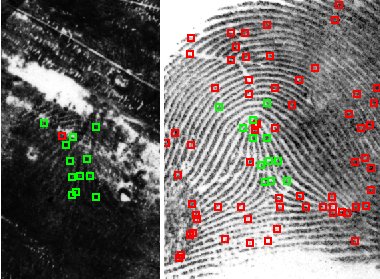
Latent fingerprint identification is of critical importance for identifying suspects. Poor quality of ridge impressions, small finger area and large non-linear distortion are the main difficulties in latent fingerprint matching, compared to plain or rolled fingerprint matching.
- A. Paulino, J. Feng, A.K. Jain, "Latent fingerprint matching using descriptor-based Hough transform", IEEE Transactions on Information Forensics and Security, vol. 8, no. 1, pp. 31-45, 2013.
- A.K. Jain, J. Feng, "Latent fingerprint matching", IEEE Transactions on Pattern Analysis and Machine Intelligence, vol. 33, no. 1, pp. 88-100, 2011.
- A. Paulino, A.K. Jain, J. Feng, "Latent fingerprint matching: Fusion of manually marked and derived minutiae", SIBGRAPI, Brazil, Aug. 2010. (Best Student Paper Award)
- J. Feng, S. Yoon, A.K. Jain, "Latent fingerprint matching: fusion of rolled and plain fingerprints", International Conference on Biometrics (ICB), pp. 695-704, 2009.
- A.K. Jain, J. Feng, A. Nagar, K. Nandakumar, "On matching latent fingerprint", CVPR Workshop on Biometrics, pp. 1-8, 2008.
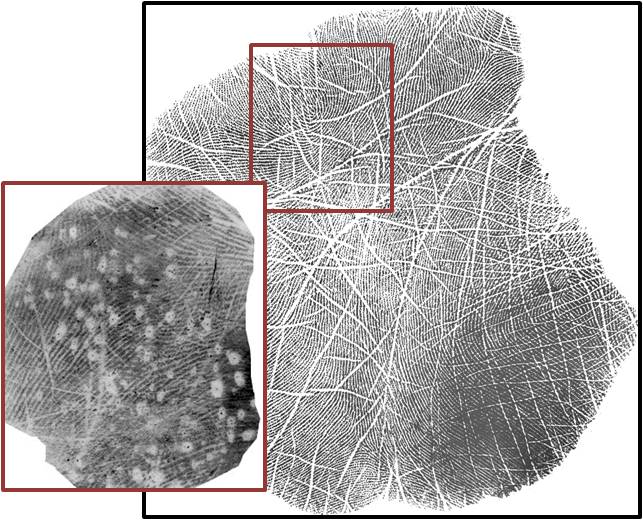
Latent palmprint matching is a challenging problem because latent prints lifted at crime scenes are of poor image quality, cover only a small area of the palm, have a complex background and many creases.
- J. Dai, J. Feng, J. Zhou, "Robust and efficient ridge-based palmprint matching", IEEE Transactions on Pattern Analysis and Machine Intelligence, vol. 34, no. 8, pp. 1618-1632, 2012. (project)
- X. Yang, J. Feng, J. Zhou, "Palmprint indexing based on ridge features", IJCB, Washington, DC, Oct. 11-13, 2011. (software)
- A.K. Jain, J. Feng, "Latent palmprint matching", IEEE Transactions on Pattern Analysis and Machine Intelligence, vol. 31, no. 6, pp. 1032-1047, 2009. (software)
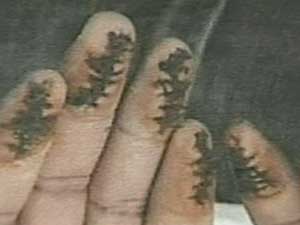
Fingerprint quality assessment is important for capturing high quality fingerprints and detecting uncooperative behaviors. We propose several algorithms to detect low quality fingerprints caused by different factors.
- X. Si, J. Feng, J. Zhou, Y. Luo, "Detection and rectification of distorted fingerprints", IEEE Transactions on Pattern Analysis and Machine Intelligence, 2014 (To appear).
- Y. Su, J. Feng, J. Zhou, "A video surveillance system for fingerprint acquisition", 7th IEEE Conference on Industrial Electronics and Applications (ICIEA), Singapore, July 18-20, 2012. (Best Paper Award)
- S. Yoon, J. Feng, A.K. Jain, "Altered fingerprints: analysis and detection", IEEE Transactions on Pattern Analysis and Machine Intelligence, vol. 34, no. 3, pp. 451-464, 2012.
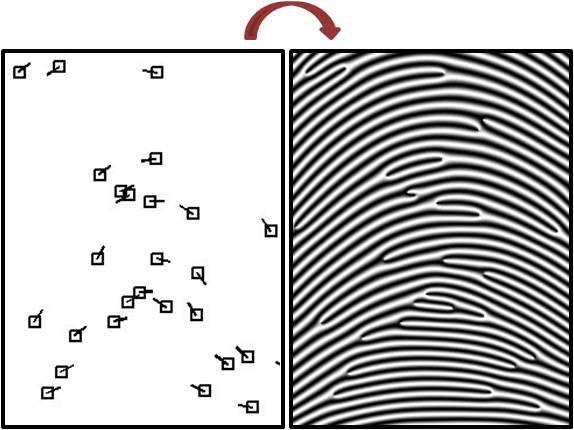
The compactness of minutiae representation has created an impression that minutiae does not contain sufficient information to allow the reconstruction of the original fingerprint image. This opinion is challenged by the proposed fingerprint reconstruction technique. The proposed technique also has other uses, such as reconstructing latent prints using minutiae marked by human experts, and improving the performance of fingerprint recognition systems with limitted storage space.
- J. Feng, A.K. Jain, "Fingerprint reconstruction: from minutiae to phase", IEEE Transactions on Pattern Analysis and Machine Intelligence, vol. 33, no. 2, pp. 209-223, 2011. (software)
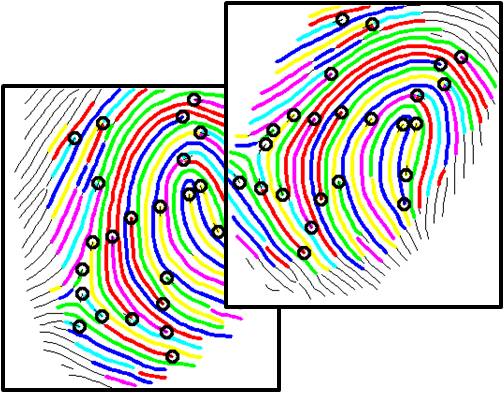
The most popular fingerprint representation is based on minutiae points, which is a compact and lossy representation of ridge skeleton, the Level 2 representation of fingerprints. Here we explore matching ridge skeletons directly for the purpose of completely utilizing the discriminating power of Level 2 features in fingerprints.
- J. Feng, Z. Ouyang, A. Cai, "Fingerprint matching using ridges", Pattern Recognition, vol. 39, no. 11, pp. 2131-2140, 2006.
- J. Feng, A. Cai, "Fingerprint indexing using ridge invariants", International Conference on Pattern Recognition, vol. 4, pp. 433-436, 2006.
- J. Feng, A. Cai, "Fingerprint representation and matching in ridge coordinate system", International Conference on Pattern Recognition, vol. 4, pp. 485-488, 2006.
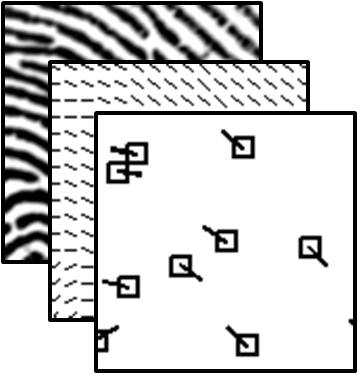
Establishing minutiae correspondence between two fingerprints is difficult due to unknown alignment, nonlinear deformation, noise, and occlusion. Designing robust minutia descriptors is a way to facilitate this problem.
- J. Feng, J. Zhou, "A performance evaluation of fingerprint minutia descriptors", International Conference on Hand-based Biometrics (ICHB), Hong Kong, 2011.
- J. Feng, "Combining minutiae descriptors for fingerprint matching", Pattern Recognition, vol. 41, no. 1, pp. 342-352, 2008.
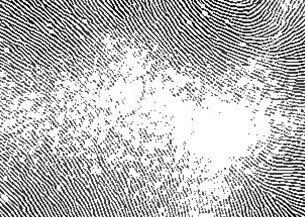
Statistical modeling of friction ridge patterns is a fundamental problem and can be used in both synthesis and analysis of friction ridge patterns.
- J. Feng, H. Zhou, J. Zhou, "A preliminary study of handprint synthesis", 6th Chinese Conference on Biometric Recognition (CCBR), pp. 133-140, Beijing, 2011.
- J. Feng, A.K. Jain, J. Zhou, "Statistical modeling of fingerprint minutiae", Intelligent Vision Group at Tsinghua University, Technical Report, THU-IVG-TR-2011-1, Jan. 2011.